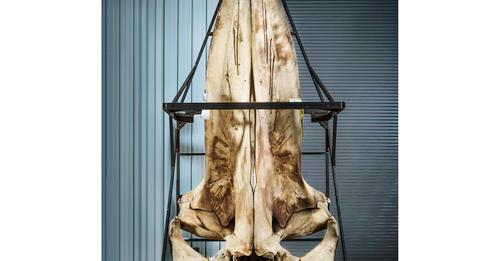:focal(2021x1520:2022x1521)/https://tf-cmsv2-smithsonianmag-media.s3.amazonaws.com/filer_public/8d/5b/8d5b7060-f6a5-49b1-a85e-ffbf11590d2f/bluewhale_revc_copy.jpg)
Chris Gunn
By the turn of the 20th century, the United States National Museum—now the Smithsonian’s Arts and Industries Building—had assembled an impressive display of whale skeletons. But for biology curator Frederick W. True, the collection would not be complete until it included a “blower,” or a whale of truly epic proportions. A pioneer in the study of taxonomy and evolutionary relationships among whales, True specifically wanted a specimen of the largest living animal on earth, the sulphur-bottom whale—more commonly known as a blue whale.
Back then, most scientists and ordinary citizens saw whaling as an innocuous industry that pursued a seemingly unlimited supply of the world’s “monsters of the deep,” as the media was fond of calling whales. At this time, big was also “a big thing,” says John Ososky, a marine mammal specialist at the Smithsonian National Museum of Natural History. The American public in the early 20th century was in the grips of dinosaur-mania, when it was common practice for huge skeletons and fossils to go on public display, and there was great demand to see these awesome creatures, Ososky adds. “True was definitely aware of the value of enticing the public with an enormous specimen.”
To fulfill the museum’s quest for a giant, True traveled to Newfoundland, Canada, and enlisted the help of local whalers. The nautical networking paid off in the summer of 1903, when whalers at Hermitage Bay brought in a 78-foot-long, 70-ton adult male North Atlantic blue whale. Waiting on the boat ramp, True’s museum colleagues snapped into action and began plastering the animal’s tail before the rest of the body had even been fully hauled out of the water. They spent the next ten hours working from tail to head to make a full-body cast of the dead animal.
The plaster model wasn’t all the Smithsonian scientists were after, though. Because models are not actual natural history specimens, the cast would be of little scientific value for studying the morphology and life histories of blue whales. So the team also collected the skeleton of the “mammoth whale,” as the newspapers referred to it. Both model and skeleton were displayed at the 1904 St. Louis World’s Fair before making their way to the Smithsonian. More than a century later, the animal’s skull is thought to be one of the largest in any scientific collection in the world.
In 1916, two years after True died, the Hall of Marine Life opened at what is now known as the National Museum of Natural History. For more than four decades, the skull and model entertained visitors who came to marvel at a whale of such size that it could provide “commodious quarters for Jonah,” as one headline proclaimed.
By the 1960s, though, sensibilities had changed. The modern environmental movement was blossoming in the U.S., and reports of steeply declining species had propelled conservation to the forefront of scientists’ minds. In preparation for a new exhibition that opened in 1963 called “Life in the Sea,” Smithsonian curators took down the old blue whale model.
Unlike the model, the original blue whale skull was featured in the new show. But now the former object of celebration and wonder had transformed into a poignant symbol of loss. As Arthur Remington Kellogg, assistant secretary of the Smithsonian, lamented in his speech heralding the new exhibition, “We are now observing the closing days of the existence of the blue whale in our oceans. Indeed, some of you at this opening may never again have the opportunity to see a real blue whale except in museums.”
Fortunately, Kellogg’s dire predictions did not come to pass. Although it’s estimated that 99 percent of blue whales disappeared during the era of commercial whaling, in recent decades, the species’ population has rebounded in a major way, with between 10,000 and 25,000 populating our oceans today. This uptick is due mainly to new conservation legislation, which was shaped in part by Smithsonian scientists—especially mammals curator Charles Handley. A strong supporter of the 1972 Marine Mammal Protection Act, Handley succeeded in efforts to list eight large whale species under the Endangered Species Conservation Act, the legislative predecessor to the Endangered Species Act of 1973. An international moratorium on commercial whaling, which most countries have abided by since 1985, also helped blue whales recover. In a way, the skull assisted in ushering in these changes, too. “Public awareness of whales and their plight led to political and legislative action to protect them,” Ososky says. “An iconic specimen such as our blue whale skull certainly played a role in that.”
By the time the “Life in the Sea” exhibition closed in 1998, the blue whale skull had accomplished its mission of helping bring its species back from the edge of extinction. So Smithsonian curators decided to retire the old skull from public view in favor of spotlighting species that currently face more pressing conservation threats, such as right whales and, more recently, Rice’s whales. The Rice’s whale exhibit, which opened in the Sant Ocean Hall in November, features a baleen plate from a deceased whale along with plastic extracted from the animal’s stomach. Since 2007, the blue whale skull has quietly resided at the Garber Preservation, Restoration and Storage Facility in Suitland, Maryland, in a room where the 25-foot-high ceiling is just tall enough to accommodate it. For now, there are no immediate plans to put the gargantuan relic back on public display. But someday, perhaps, the skull will reappear in an exhibition showcasing the conservation that helped to save some of the ocean’s most majestic creatures.

/https://tf-cmsv2-smithsonianmag-media.s3.amazonaws.com/filer_public/4f/df/4fdf6eb6-84ac-417d-b362-acd854814dbc/microsoftteams-image_2.png)